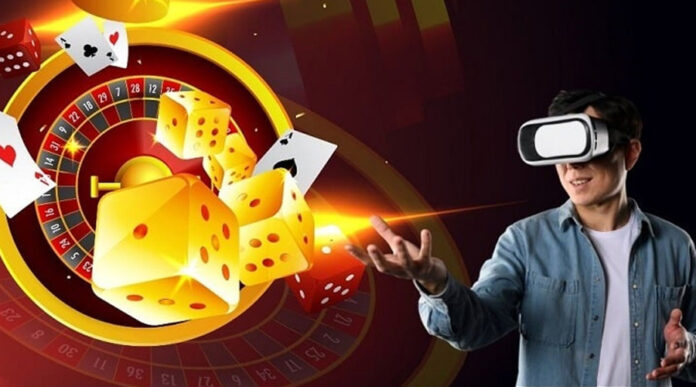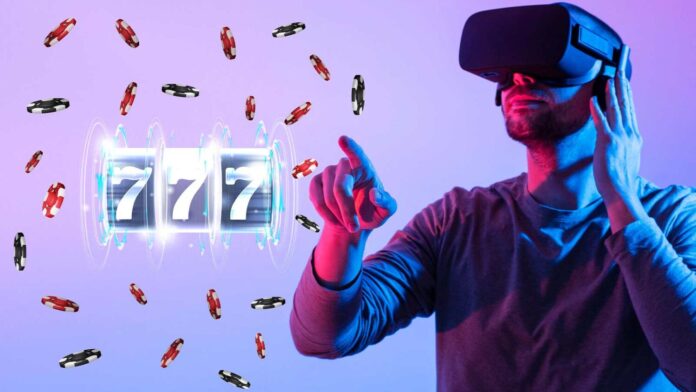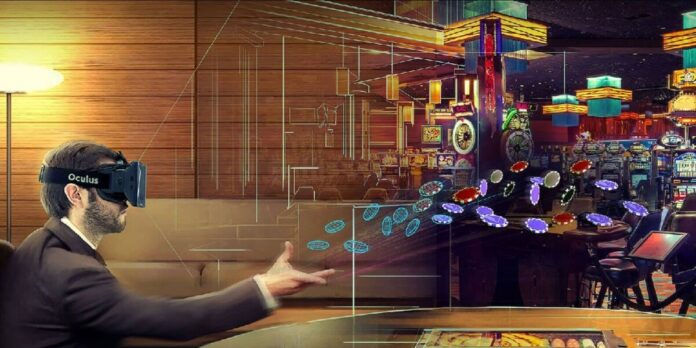
From the vibrant streets of Venice in the 17th century, where the world’s first official casino, Casinò di Venezia, opened its ornate doors, to the digital platforms we frequent today, the realm of casino gaming has undergone an astonishing metamorphosis.
Originally established as exclusive domains for the elite, casinos gradually became more accessible to the masses, with each era introducing its flavor of games and entertainment.
From card games that required skill and strategy, like blackjack card counting, to the addictive allure of slot machines, each addition has been a testament to the changing tastes and growing sophistication of the gaming audience.
As with many industries, the digital age ushered in a monumental shift in the world of gambling. Online casinos offered gamblers the unprecedented luxury of playing from the comfort of their homes, without the need for a physical presence.
This convenience, combined with an ever-expanding range of online games, skyrocketed the popularity of digital gambling.
However, technology never remains stagnant. As we ventured further into the 21st century, a new player emerged on the scene, promising to redefine our gaming experiences: Virtual Reality (VR). VR, with its headsets and motion-sensing equipment, offers a level of immersion that is leagues beyond traditional online platforms.
Instead of merely watching a game unfold on your screen, you are transported into the very heart of the action, enabling a sensory experience that mimics, and sometimes even surpasses the real-world casino ambiance.
The Rise of Virtual Reality in Gaming

The origins of Virtual Reality, while rooted in gaming, have always been entwined with broader technological ambitions. As early as the 1960s, visionaries like Morton Heilig envisioned a multisensory experience, culminating in the creation of the “Sensorama,” an arcade-styled machine that could stimulate multiple senses.
However, it was in the late 1980s and early 1990s that the term ‘Virtual Reality’ came into the popular lexicon, largely credited to Jaron Lanier, the founder of the pioneering VR company, VPL Research.
The promise of VR was always grand: a digital realm where users could lose themselves, breaking the boundaries between reality and simulation. However, the initial surge of interest in VR was hampered by technological limitations and high costs, causing many early endeavors to fizzle out.
However, with the rapid advancements in computer technology and graphics processing in the early 2000s, VR found a more fertile ground to germinate. The gaming industry, always at the forefront of tech adoption, was quick to see the potential.
Pioneering Pixels: Milestones that Mattered
- 2012: Oculus Rift’s Kickstart: A pivotal moment in VR’s history was when Palmer Luckey launched a Kickstarter campaign for the Oculus Rift. Garnering immense interest and funding, this device brought VR back into the spotlight, indicating a newfound readiness in both the industry and among consumers.
- 2016: Commercial VR Takes Flight: This year was monumental. Oculus Rift, HTC Vive, and Sony’s PlayStation VR were launched, marking the beginning of modern VR gaming. With competitive pricing and a growing library of games, VR was now within reach of the average consumer.
- Beat Saber and Beyond: If one were to pinpoint a game that captured the imagination of VR enthusiasts and novices alike, it would be Beat Saber (2018). Its intuitive gameplay, combined with the immersive VR experience, turned it into an instant classic, proving that VR games could be both fun and wildly popular.
- Multiplayer and Social VR: As the technology matured, games like VRChat and Rec Room began to emerge, focusing not just on gameplay, but also on social interaction in virtual spaces. This gave players a new dimension of engagement, amplifying the appeal of VR.
Understanding the concept of responsible gambling is vital when exploring the evolution of casino games, as elaborated in this article.
The transition from Traditional to VR Casinos

Stepping into a traditional casino is to immerse oneself in a world of opulence – the glittering chandeliers, the clatter of chips, and the soft hum of whispered bets. These establishments, epitomized by the grandeur of places like Las Vegas and Monaco, have long been the gold standard for gambling enthusiasts.
Yet, beneath this façade of elegance, they grapple with challenges that are increasingly hard to ignore in our modern era.
- Spatial Limitations: Every slot machine, poker table, or roulette wheel occupies precious real estate. Expanding or redesigning can involve significant costs and logistical nightmares. This limited space often means a cap on the number of games or variations a casino can offer.
- Geographical Barriers: For many, the dream of strolling down the Las Vegas strip remains just that – a dream. The location of premier casinos often necessitates expensive travel, accommodations, and other associated costs, limiting access to a privileged few.
- Overhead Costs: Running a brick-and-mortar casino isn’t cheap. There’s rent or property maintenance, staff salaries, utilities, security, and more. These overheads often translate to higher costs for the consumer in terms of entry fees or higher house edges.
Exploring the evolution of casino games, it’s evident how video games are shaping future of gambling – discover more in our article about their influence.
Digital Dimensions – The Allure of VR Casinos
Virtual Reality, with its promise of boundless digital landscapes and immersive experiences, offers an attractive solution to many traditional casino challenges.
- Unbridled Accessibility: The most evident advantage is the elimination of geographical barriers. With a VR headset and a stable internet connection, anyone from Tokyo to Toronto can step into a virtual casino, experiencing the thrill of gambling without ever boarding a flight or booking a hotel.
- Expansive Gaming Arenas: Digital space is, for all intents and purposes, infinite. VR casinos aren’t constrained by physical boundaries. This means a broader variety of games, unique themes, and customizable environments tailored to individual preferences.
- Cost-Effective Operations: While developing a VR casino might require a significant initial investment, the running costs are dramatically lower than their physical counterparts. This can potentially lead to more favorable odds or bonuses for players, making the games more enticing.
- Enhanced Social Interactions: Traditional online casinos may offer chat functions, but VR takes social interaction to the next level. Players can read body language, interact in real-time, and engage in conversations, replicating the social nuances of a physical casino.
Exploring the evolution of casino games sheds light on the intriguing reasons behind humans’ strong affinity for gambling – find more insights in this article.
Features and Benefits of VR Casino Games

In a rapidly digitalizing world, the bar for entertainment is perpetually raised. Virtual Reality (VR) has surfaced as a frontrunner in this race, combining technological prowess with visceral experience. Within the gambling realm, VR casinos are fast carving a niche, and their popularity can be largely attributed to the following features:
Immersive Experience: Stepping Beyond Reality’s Borders
- 360-Degree Gaming Panorama: Traditional online casinos provide a 2D interface, with players essentially looking at a flat representation of a game. VR casinos, on the other hand, plunge players into a 360-degree world. This all-encompassing view ensures that every toss of a card, spin of a roulette wheel, or flash of a slot machine feels incredibly real, encapsulating players within the game’s atmosphere.
- Authenticity in the Virtual Domain: The hallmark of a VR casino is its ability to recreate the sensations of a real casino. The ambient sounds of distant chatter, the tactile sensation of chips in hand (through haptic feedback), and even the simulation of a dealer’s smile—all these minute details culminate in an experience that can rival, if not surpass, the real deal.
Social Interaction: Mingling in the Matrix
- Real-time Player Engagement: While traditional online casinos did offer chat boxes, they often felt detached. VR casinos redefine this by allowing players to converse and interact in real-time. Whether it’s celebrating a win, sharing a strategy, or simply engaging in light banter, these interactions are fluid, natural, and deeply enriching.
- Avatars & Lifelike Gaming Desks: Gone are the static usernames and bland icons. In a VR casino, each player can customize their avatar, infusing their virtual self with unique quirks and features. These avatars, seated around ultra-realistic gaming tables, further elevate the sensation of being in an actual casino, allowing for non-verbal cues, gestures, and a genuine sense of presence.
As you journey through the transformation of casino games, delve into the changing landscape of casino bonuses in our related article.
Variety and Customization: A Gambler’s Wonderland
- Limitless Virtual Chambers: The boundless nature of digital space is a boon for VR casinos. Unlike traditional casinos that might be restricted by square footage, VR casinos can host an astonishing variety of rooms, each with distinct themes. From an opulent casino reminiscent of Monaco’s luxury to a futuristic space-themed gambling den, the options are only limited by imagination.
- Tailored Gaming Adventures: In a VR casino, personalization is paramount. Beyond choosing avatars or rooms, players can adjust game settings, select specific music, or even change the ‘time of day’ in their virtual environment. This degree of customization ensures that every player’s experience is uniquely tailored to their preferences, making each visit a new adventure.





